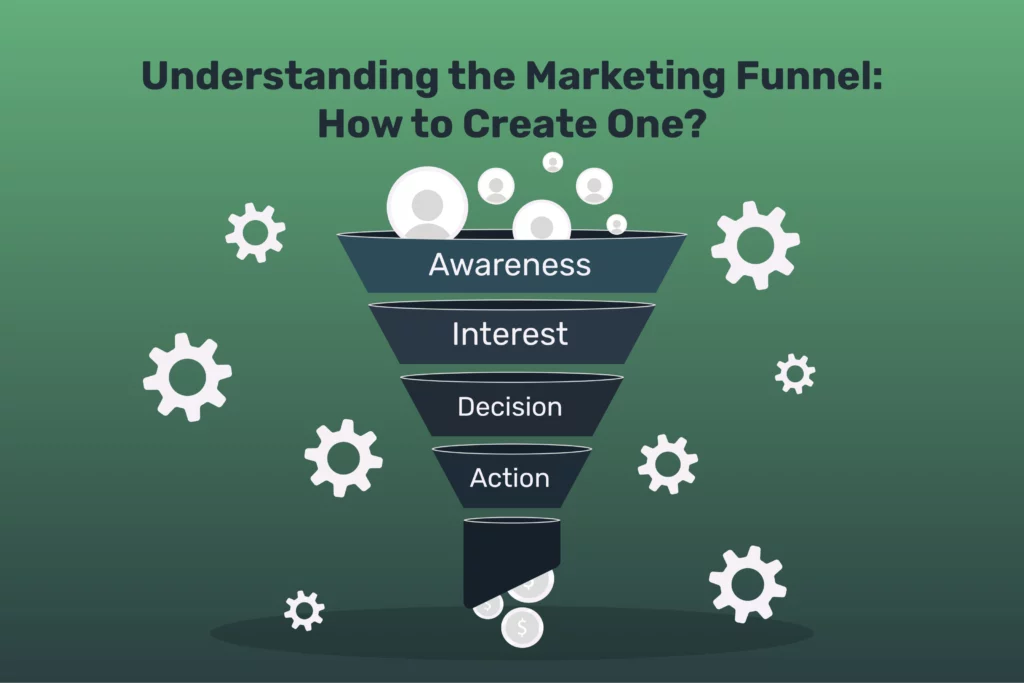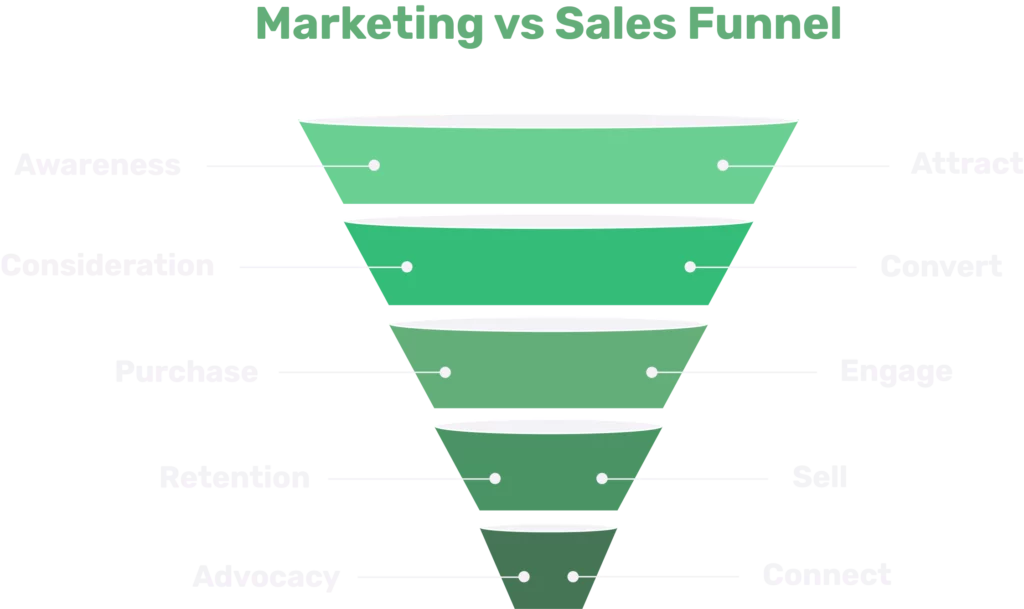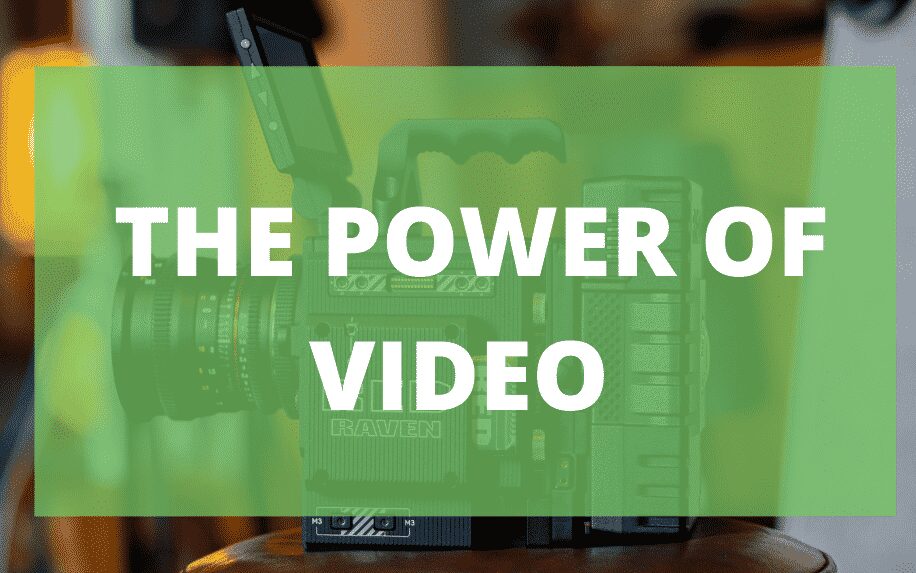In the current competitive business landscape, understanding the marketing funnel is crucial for the success of any marketing strategy. The marketing funnel is an essential concept in marketing and sales that outlines the various stages a potential customer goes through before purchasing. It provides marketers with a strategic framework to guide their efforts in reaching and converting prospects into loyal customers.
Keep reading to learn more about the marketing funnel stages to help you create one compatible with your business.
Understanding the Marketing Funnel

A marketing funnel visualises the customer journey from the initial awareness stage to the ultimate goal of purchasing. It is divided into several stages, starting from the beginning of the funnel, where potential customers are introduced to a product or service, to the bottom of the funnel, where they make a purchase and become usual customers.
Stages of a Typical Marketing Funnel
Imagine it like a giant funnel at the top where you attract a broad audience. As they progress through the stages, the “mouth” of the funnel gets narrower, representing those who become more engaged and eventually convert into paying customers.
Awareness
This is the widest part of the funnel, where you’re trying to grab attention and generate interest in your brand. This could be through channels like social media ads, blog posts, search engine optimisation, or offline methods like billboard advertising.
Interest
Once people know you, you need to keep their interest and get them to learn more. This might involve offering valuable content like eBooks, webinars, or free trials or interacting with them on social media.
Consideration
This is where people actively compare their options and consider whether to purchase. You need to provide them with relevant information and highlight the benefits of your product or service to convince them you’re the best choice.
Decision
This is the point where people decide whether to buy from you. Ensure your website is user-friendly and the checkout process is smooth to avoid losing them at the last hurdle.
Advocacy
Ideally, the funnel doesn’t end at purchase. You can turn happy customers into loyal advocates who recommend your brand to others by providing excellent customer service and exceeding expectations.
Importance of the Marketing Funnel
- Understand your audience: By mapping the customer journey, you understand their needs and pain points at each stage.
- Focus your marketing efforts: You can tailor your content and messaging to each funnel stage, ensuring you deliver the correct information at the right time.
- Optimise your campaigns: Track your results at each stage to identify what’s working, then adjust your campaigns accordingly.
- Increase conversions: By guiding customers through the funnel, you can increase their chances of purchasing.
How Does Marketing Funnel Work?
The marketing funnel allows marketers to implement targeted marketing tactics and activities at each stage of the funnel to optimise the customer journey. From building brand awareness at the top of the funnel to nurturing prospects in the middle and driving conversions at the bottom, the marketing funnel serves as a roadmap for guiding potential customers through the buying process.
In the marketing funnel model, potential customers progress through various stages before purchasing. The top of the funnel, also known as the awareness stage, is where prospects first become acquainted with a product or service.
This is where brand awareness is crucial, and marketing efforts are focused on attracting the target audience’s attention through different marketing channels such as digital marketing, content marketing, and email marketing. Creating compelling and valuable content through blogs, social media, and informative landing pages can help drive traffic and capture the interest of new customers.
As prospects move down the funnel to the middle stage, known as consideration, they evaluate the product or service. Marketers employ tactics like engaging content, case studies, and free trials to nurture leads and provide relevant information to guide them toward a purchase. Metrics such as engagement rate, conversion rate, and click-through rate are crucial at this stage to measure the success of marketing activities and identify potential areas for optimisation.
At the bottom of the funnel, the emphasis shifts to conversion. This is where the prospect makes the purchase and becomes a loyal customer. Here, the marketing team focuses on implementing targeted marketing tactics and strategies to encourage the prospect to take action, such as personalised messaging, special offers, and compelling calls to action.
The success of the marketing funnel can be measured through metrics like conversion rates, average order value, and customer lifetime value, which provide insights into the effectiveness of the marketing efforts at converting prospects into customers.
Creating a Marketing Funnel
Creating a successful marketing funnel requires a strategic approach that takes your target audience from awareness to conversion and beyond. Here are some essential tips to guide you through the process:
Define Target Audience
Start with understanding your ideal customer. Create buyer personas to understand your ideal customer’s needs and desires, then craft marketing that feels like a conversation, not a megaphone.
Tips for Creating Buyer Personas
Developing strong buyer personas is crucial for understanding your audience, tailoring your marketing, and ultimately driving conversions. Here’s a deeper look at the process:
Gather Data
- Existing Customers: Analyse your customer demographics, purchase history, website behaviour, and feedback from surveys, interviews, and customer service interactions.
- Market Research: Use industry reports, competitor analysis, and social media insights to understand broader trends and target audience preferences.
Identify Commonalities
- Group customers by similarities: Look for patterns in demographics, behaviour, goals, and challenges. You might have different personas for age groups, job titles, or purchasing decisions.
- Focus on qualitative insights: Go beyond demographics. Understand motivations, fears, and values that drive their decisions.
Develop Persona Profiles
- Give each persona a name and visual identity: This helps make them relatable and real.
- Include demographics: Age, gender, location, income, education, etc.
- Define their psychographics: Values, interests, personality traits, lifestyle, goals, and challenges.
- Outline their buyer’s journey: How do they become aware of your brand, consider options, and make purchasing decisions? What information do they need at each stage?
- Include quotes and anecdotes: Use real customer quotes to personalise and bring the persona to life.
Use Your Personas
- Inform marketing campaigns: Tailor messaging, content, and visuals to resonate with each persona.
- Develop targeted content: Create blog posts, social media content, and landing pages specific to each persona’s needs and interests.
- Personalise the customer experience: Address their unique challenges and tailor communication to their preferred channels.
- Align sales and marketing efforts: Ensure everyone understands the ideal customer and their decision-making process.
Bonus Tips
- Get everyone involved: Encourage collaboration from marketing, sales, and customer service teams for a holistic perspective.
- Update regularly: Your personas should evolve as your business and market change.
- Use persona templates and tools: Several online resources can help you create and manage your personas.
Map Out the Customer Journey
Once you know your target audience, you can map out their steps, from becoming aware of your brand to making a purchase. This will help you identify how to interact with them and move them closer to conversion.
Develop Content
Create valuable content that addresses your target audience’s needs and interests at each funnel stage. For example, you might focus on educational blog posts or social media content at the awareness stage. In the consideration stage, you could offer white papers, case studies, or free trials. At the decision stage, you might provide product demos or testimonials.
Use Lead Magnets
Offer valuable incentives, such as eBooks, webinars, or discount codes, in exchange for contact information. Accordingly, you can build your email list and nurture leads through the funnel.
Email Marketing
Once you have captured leads, use email marketing to stay in touch with them and move them closer to conversion. Send them relevant content, special offers, and personalised messages that address their needs.
Retarget Website Visitors
Many people who visit your website will leave without making a purchase. Use retargeting ads to encourage them to buy from your brand.
Track Your Results
Tracking your results at each stage of the funnel is essential to evaluate your progress. Use analytics tools to track your data, like website traffic, email open rates, click-through rates, and conversion rates. This data will help you make informed decisions about improving your funnel.
Implementing marketing funnel metrics is essential for measuring the performance and effectiveness of the marketing funnel. Businesses can track key metrics by using tools such as Google Analytics and other marketing analytics platforms. These metrics allow marketers to identify areas for improvement and optimise their marketing strategies for better results.
Optimise Your Funnel
Don’t be afraid to experiment and change your funnel based on your data. A/B tests headlines, calls to action, and landing pages to see what performs best.
Conducting A/B Testing
A/B testing is one of the powerful techniques for optimising the marketing funnel. By testing different variations of marketing materials, such as landing pages, email campaigns, and ad creatives, marketers can determine which elements interest their target audience and drive the highest conversion rates. This iterative approach to testing and optimisation allows marketers to continually refine their strategies to maximise their marketing efforts and improve the overall performance of the funnel.
Implementing Loyalty Programs
Loyalty programs are another valuable tool for optimising the marketing funnel. By implementing rewards and incentives for repeat purchases and customer referrals, businesses can encourage loyalty and repeat business, ultimately driving revenue and maximising the lifetime value of customers. Loyalty programs can nurture existing customers and turn them into brand advocates, contributing to the overall success of the marketing funnel.
The Difference Between the Marketing and Sales Funnel

Understanding the differences between marketing and sales funnel is crucial for optimising your overall strategy and ensuring a smooth path for potential customers to become loyal patrons.
Key Differences
- Target audience: The marketing funnel targets a broader audience, while the sales funnel focuses on qualified leads.
- Content: Marketing content is educational and informative, while sales content is persuasive and solution-oriented. Howvever, using both content management software and sales content management software helps to organize, share, and track client-facing content.
- Metrics: Marketing metrics focus on awareness and engagement, while sales metrics focus on conversions and revenue.
- Tools: Marketing uses content and digital tools, while sales rely on CRM systems and direct interaction.
The marketing funnel primarily focuses on the initial stages of the customer journey, from generating awareness to cultivating interest and consideration. In contrast, the sales funnel is more concerned with the final stages of the journey, including the actual purchase and post-purchase activities. Understanding these distinctions is essential for developing a comprehensive full-funnel marketing strategy that effectively guides prospects through every stage of the funnel.
Marketing Funnel Example: Netflix
Netflix, the streaming giant, has mastered the art of the marketing funnel, continuously attracting new subscribers and keeping existing ones engaged. Here’s a breakdown of their funnel:
Awareness
- High-budget content production: Original series and films generate buzz through trailers, social media campaigns, and celebrity endorsements.
- Strategic partnerships: Collaborations with established franchises (e.g., Stranger Things and Marvel) attract dedicated fanbases.
- Awards and accolades: Highlighting critical acclaim and prestigious awards builds prestige and attracts discerning viewers.
- Word-of-mouth marketing: Loyal subscribers become brand ambassadors, recommending shows and encouraging others to sign up.
Interest
- Free trials: Offering a one-month (or longer) free trial allows potential subscribers to experience the platform and its vast library firsthand.
- Personalised recommendations: Using sophisticated algorithms, Netflix curates tailored lists based on watch history, genres, and user preferences.
- Targeted social media advertising: Ads showcasing specific shows or actors likely to resonate with user interests and past viewing habits.
- Content teasers and trailers: Short clips and trailers keep viewers engaged and curious about upcoming shows and movies.
Consideration
- Multiple subscription tiers: Different price points and features (HD, simultaneous streams) cater to various budgets and viewing habits.
- Bundle offers: Combining Netflix with other streaming services or internet plans incentivises subscriptions.
- User-friendly interface: The intuitive platform makes exploring content, adding to watchlists, and managing profiles effortless.
- Offline viewing: Downloading movies and shows for offline viewing increases accessibility and caters to mobile and travel-centric users.
Decision
- Streamlined signup process: Easy-to-follow steps with minimal payment and account creation friction encourage conversion.
- Cancel anytime policy: Removing commitment barriers and emphasising flexibility eases concerns and increases subscription confidence.
- Promotional offers and discounts: Limited-time deals or trial extensions incentivise immediate signups for hesitant users.
- High-quality content library: Continuously adding acclaimed originals, diverse genres, and classic favourites reinforces Netflix’s value proposition.
Post-Purchase
- Personalised recommendations: Continued suggestions based on watch history ensure engagement and discovery of new content.
- Notifications and reminders: Alerts about new seasons, trending shows, and personalised picks encourage continued viewing.
- Interactive features: Interactive elements like quizzes and polls increase user engagement and create a sense of community.
- Exclusive content and early access: Offering subscribers bonus scenes, special episodes, and early previews rewards loyalty and incentivises continued subscriptions.
Netflix’s success lies in its comprehensive funnel, catering to every stage of the customer journey. By leveraging high-quality content, personalised recommendations, convenient features, and strategic marketing efforts, they effectively attract, engage, and retain subscribers, solidifying their position as the global streaming leader.
The marketing funnel is simplified, and customer journeys can be more complex. However, it’s a valuable tool for understanding your audience and improving your marketing effectiveness. Marketers can create a seamless and rewarding customer journey that fosters loyalty, drives conversions, and ultimately fuels business growth.
FAQ
What metrics are used to measure the effectiveness of a marketing funnel?
Standard metrics include conversion rate, customer acquisition cost, lifetime value, lead-to-customer ratio, and return on investment (ROI).
How can social media be incorporated into the marketing funnel?
Social media can be used at various marketing funnel stages to create awareness, engage potential customers, and nurture leads. For example, at the top of the funnel, social media posts can generate awareness, while targeted ads can drive conversions at the middle and bottom of the funnel.
What are some common types of marketing strategies used throughout the marketing funnel?
Common marketing strategies throughout the funnel include search engine optimisation (SEO), content marketing, email marketing, social media advertising, pay-per-click (PPC) advertising, and influencer marketing.
Why is it important for marketing and sales teams to align around the marketing funnel?
It is crucial for marketing and sales teams to align around the marketing funnel to ensure the transition of leads from marketing to sales, to provide a unified customer experience, and to upgrade the efficiency and effectiveness of the overall sales and marketing efforts.
How can a business evaluate the success of its marketing funnel?
A business can evaluate the success of its marketing funnel by analysing key performance indicators (KPIs) such as conversion rates, customer acquisition costs, customer retention rates, and overall return on investment (ROI) from marketing efforts across different stages of the funnel.


